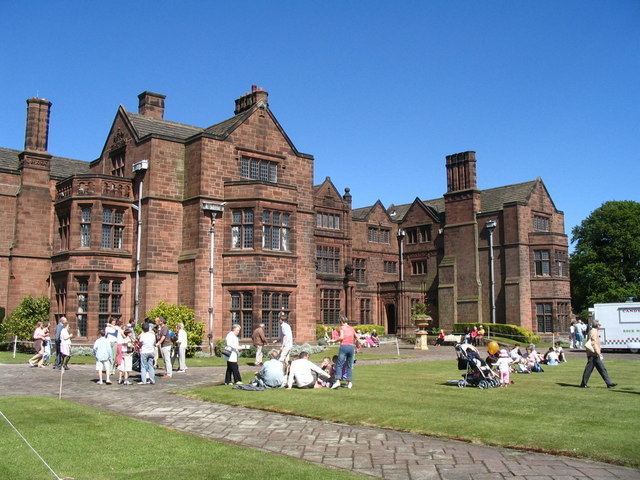OS grid reference SJ 300,817 Phone +44 151 353 1155 | Rebuilt c. 1896, 1913 Reference no. 1075420 Designated as world heritage site 2 December 1986 | |
 | ||
Similar Thornton Hall Hotel, Lucknam Park, Inglewood - Cheshire, Hill Bark, Knowsley Hall | ||
Thornton manor 4k
Thornton Manor is a large house in the village of Thornton Hough, Wirral, Merseyside, England. It is recorded in the National Heritage List for England as a designated Grade II* listed building. The house was first built in the middle of the 19th century and has been altered and extended in a number of phases since. From 1888 to the end of the 20th century the house was occupied by the Viscounts Leverhulme. It is now used as a conference and events centre, and a venue for weddings.
Contents
- Thornton manor 4k
- Thornton manor wedding venue cheshire
- History
- Leverhulme Era
- Architecture
- Grounds
- Present day
- References
Thornton manor wedding venue cheshire
History
The land on which the house stands was owned originally by the Mostyn family of North Wales. The land was bought in 1849 by Charles William Potts, a solicitor. It is thought that he built the manor house, but there is no evidence that he lived there. In 1863 Potts sold the house and land to Thomas Brittain Forwood, a businessman who died in 1884. His son, Sir William Forwood, chairman of Liverpool Overhead Railway, let the house to William Lever (later 1st Viscount Leverhulme), builder of the soap factory and model village at Port Sunlight, in 1888.
Leverhulme Era
Thornton Manor became the home of the Viscount Leverhulmes. William Lever bought the house in 1893 and lived here from 1888 until 1919, retaining ownership until his death in 1925. Lever started on a series of alterations and additions soon after his purchase. The architect Jonathan Simpson made some minor alterations but the first major work was designed by the Chester firm Douglas and Fordham in about 1896. This constituted the main block of the house and was in Elizabethan style.
In 1899 stables designed by J. J. Talbot were built and around this time a kitchen and service quarters designed by Grayson and Ould were added. In 1902 a music room followed, also designed by Talbot, and this formed a new block to the northeast of the main block. Two years later a temporary ballroom was built, which was later converted into a swimming pool. A porch was added to the south front in 1906, changing the main entrance to the house from the west to the south. A gatehouse designed by J. Lomax-Simpson was built in 1910; the base of this is in stone and its upper part is half-timbered.
In 1913 a major reconstruction of the house took place when Elizabethan-style wings were added to the west side of the house. Lomax-Simpson was again the architect. In the process of the reconstruction, most of the work designed by Douglas and Fordham was demolished, leaving from their design only two shaped gables and semicircular bay windows. Plans for further enlargement of the house were prepared by Lomax-Simpson, but these were not built because of the intervention of the First World War. The 1st Viscount Leverhulme died in 1925 and the house was inherited by his son, William Hulme Lever, 2nd Viscount Leverhulme. He died in 1949 and the house passed to his son, Philip Lever, 3rd Viscount Leverhulme. Philip Lever died in 2000 and the following year the house was sold with planning permission to convert it into a hotel. The house contents sale broke the UK record by raising £10 million in 2001.
Architecture
The house is built in stone with slate roofs. It has three storeys and an irregular plan. The entrance front faces southwest and has protruding wings on both sides. Behind the house, at an angle towards the northeast, is the wing containing the music room. The windows are mullioned and a number of them are in canted, two-storey bays. The stables extend to the northwest.
Grounds
The park was first laid out during Forwood's ownership. It included paths, a small summer house and a bridge. The gardens as they now are were planned by Thomas H. Mawson and the 1st Viscount. The kitchen garden contains a loggia dated 1912, and there is another loggia to the southeast of the house; both were designed by Lomax-Simpson. To the northeast of the house is a structure known as The Lookout, which was designed in 1896 by Douglas and Fordham. A lake lies to the west of the house. A system of tree-lined avenues was laid out in 1912–14 by Lomax-Simpson, and has a total length of about 5 miles (8 km).
Present day
The Manor House has been converted into a centre for conferences and corporate events. It is licensed for weddings and has a marquee overlooking the lake which can accommodate 500 people.
